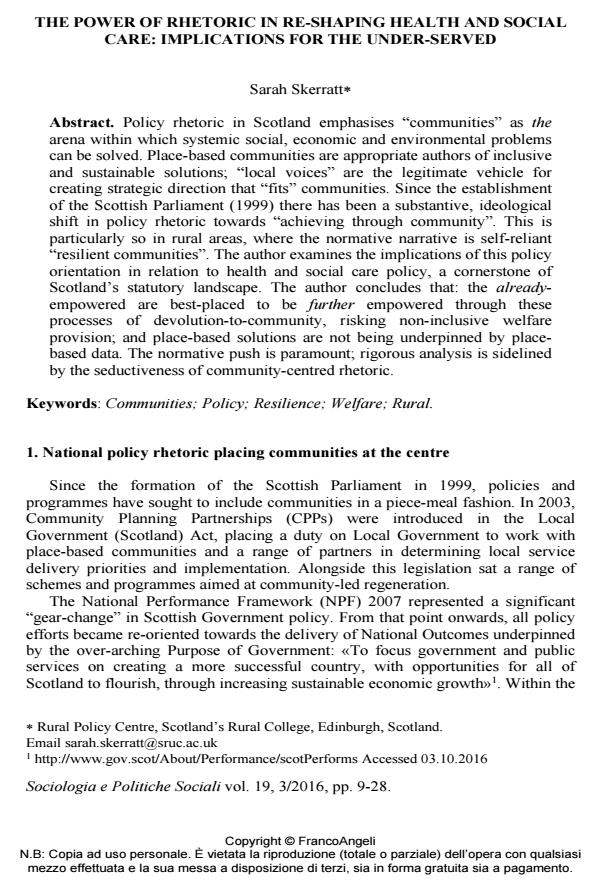The power of rhetoric in re-shaping health and social care: implications for the under-served
Titolo Rivista SOCIOLOGIA E POLITICHE SOCIALI
Autori/Curatori Sarah Skerrat
Anno di pubblicazione 2016 Fascicolo 2016/3
Lingua Inglese Numero pagine 20 P. 9-28 Dimensione file 281 KB
DOI 10.3280/SP2016-003002
Il DOI è il codice a barre della proprietà intellettuale: per saperne di più
clicca qui
Qui sotto puoi vedere in anteprima la prima pagina di questo articolo.
Se questo articolo ti interessa, lo puoi acquistare (e scaricare in formato pdf) seguendo le facili indicazioni per acquistare il download credit. Acquista Download Credits per scaricare questo Articolo in formato PDF

FrancoAngeli è membro della Publishers International Linking Association, Inc (PILA)associazione indipendente e non profit per facilitare (attraverso i servizi tecnologici implementati da CrossRef.org) l’accesso degli studiosi ai contenuti digitali nelle pubblicazioni professionali e scientifiche
Policy rhetoric in Scotland emphasises "communities" as thearena within which systemic social, economic and environmental problemscan be solved. Place-based communities are appropriate authors of inclusiveand sustainable solutions; "local voices" are the legitimate vehicle forcreating strategic direction that "fits" communities. Since the establishmentof the Scottish Parliament (1999) there has been a substantive, ideologicalshift in policy rhetoric towards "achieving through community". This isparticularly so in rural areas, where the normative narrative is self-reliant "resilient communities". The author examines the implications of this policyorientation in relation to health and social care policy, a cornerstone ofScotland’s statutory landscape. The author concludes that: the alreadyempoweredare best-placed to be further empowered through theseprocesses of devolution-to-community, risking non-inclusive welfareprovision; and place-based solutions are not being underpinned by placebaseddata. The normative push is paramount; rigorous analysis is sidelinedby the seductiveness of community-centred rhetoric.
Parole chiave:Communities; Policy; Resilience; Welfare; Rural
- Bridging One Health and Sustainability: The anatomy of a socioethical issue Antoine Boudreau LeBlanc, Jérôme Pelletier, Cécile Aenishaenslin, Olivier Beauchet, Manon Boiteux, Michèle Bouchard, Ryoa Chung, Evelyne de Leeuw, Charles Dupras, Xavier Gravend-Tirole, Timothé Poisot, Jean-Philippe Rocheleau, Nicolas Macia, Luc Stafford, in BioScience biaf008/2025
DOI: 10.1093/biosci/biaf008 - E-government in Depopulated Rural Areas. An Approach to the Reality of Spanish Municipalities Carolina Pontones-Rosa, Rosario Perez-Morote, Montserrat Nunez-Chicharro, Inmaculada Alonso-Carrillo, in Population Research and Policy Review 63/2023
DOI: 10.1007/s11113-023-09808-9
Sarah Skerrat, The power of rhetoric in re-shaping health and social care: implications for the under-served in "SOCIOLOGIA E POLITICHE SOCIALI" 3/2016, pp 9-28, DOI: 10.3280/SP2016-003002